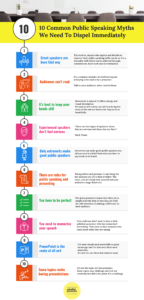
Don’t let the plethora of public speaking myths alarm you.
Despite efforts to dispel them, the world is full of tales and illusions which have stood the test of time.
Public speaking myths are no exception and continue to hurt presenters and audiences in businesses everywhere.
It’s time to challenge those unhelpful public speaking myths that persist today.
Once we do so, we can cast them aside and learn how to overcome them.
Myth 1 – Great speakers are born that way
It’s a myth that great speakers are born with the ability to connect confidently and easily with a room full of people.
The truth is, anyone who aspires and decides to improve their public speaking skills can do so. It’s a learnable skill which can be achieved through training, commitment and determination.
In his article in Forbes, Henry DeVries writes: ‘Some of the world’s most famous celebrities, from Harrison Ford to Julia Roberts to Samuel L. Jackson, have overcome their fear of speaking in public to achieve great success.’
There are many, many more!
Myth 2 – Audiences can’t read
Have you ever attended a presentation where the speaker read everything off the slide, word for word?
It’s a common mistake which is both boring and annoying when you’re on the recieving end of it.
Your audience can either listen to you speak or read. Most can’t do both effectively at the same time and don’t want to.
Talk to your audience, never read to them.
Myth 3 – It’s best to keep your hands still
Most people have been taught to avoid moving their hands while presenting. They are told it’s distracting and makes them look nervous.
It’s a myth and a huge mistake.
Movement is natural. It offers energy and visual stimulation.
It’s easy to tell a story; our job is to bring the story to life and our hands can help us do so beautifully.
Consultant Vanessa Van Edwards studied famous TED talks and found that the ones that became extremely popular featured the speakers who used their hands the most. She said, “When really charismatic leaders use hand gestures, the brain is super happy,” she said. “Because it’s getting two explanations in one, and the brain loves that.”
Myth 4 – Experienced speakers don’t feel nervous
As you develop your public speaking skills, your pre-presentation anxiety lessens.
The truth is, your nerves will never go away completely if you’re about to give a presentation you genuinely care about.
Experienced speakers simply learn how to control, manage and even harness their nerves to help them rather than hinder them.
“There are two types of speakers: those that are nervous and those that are liars.” – Mark Twain
Experienced presenters learn the ‘21 MINDFUL tools for managing presentation nerves’.
Myth 5 – Only extroverts make good public speakers
Introverts can make great public speakers too.
In her brilliant TED Talk, Susan Cain explains that introverts are not necessarily shy, but gain energy from low-key environments.
In a previous article, ‘Watch out for the quiet ones – Presenting the introvert, I shared my belief that whether you are an introvert, extrovert or any other type of ‘vert’ all you need is:
– Something important to say that will make a difference to others
– A belief that what you have to say needs to be heard
– Passion for what you believe in
– A conviction to express your passion and share your message’
Myth 6 – There are rules for public speaking and presenting
Like any other skill or field, there is best practice and things that work better than others.
That’s true in public speaking and presenting too.
It’s a public speaking myth that a number of rigid rules apply which must be followed without exception.
Taking advice and guidance is one thing but the moment you try to find or follow ‘The rules’, you are doing both yourself and your audience a huge disservice.
It takes time to find, value and express our authentic voice.
Myth 7 – You have to be perfect
In our popular article ‘ The 20 Habits of Truly Brilliant Presenters’, Habit 3 is:
‘They don’t try to be perfect’
We go on to suggest that:
‘Anxiety increases substantially when we strive for perfection. The great presenters
know that so they don’t try to go for an Oscar-winning performance. Instead, they
know that their job is simply to be the best of who they are with the sole intention
of making a difference to their audience rather than making themselves look like
superstars.’
Myth 8 – You need to memorise your speech
Your audience don’t want to hear a slick, polished presenter who has memorised everything.
It’s a myth; that’s theatre.
Your audience want to hear someone speak who :
– Knows what they are talking about
– Care about what they are saying
– Can make their audience care too
You don’t need to memorise your speech; this will do both you and your audience more harm than good.
Internalise don’t memorise
In other words, become so comfortable with your message that if you left your notes on the train or your PowerPoint failed, you could still speak. Even without slides or notes, you could still hold a good account of yourself. You’ve taken the time to make your message a part of you.
Myth 9 – PowerPoint is the route of all evil
There is nothing wrong with PowerPoint or any other visual aid software.
I’ve seen visuals used powerfully to great advantage and I’ve also seen them used miserably.
It’s how we use them that matters most.
Myth 10 – Some topics make boring presentations
It’s not the topic, it’s the presenter.
Some topics may challenge and test our creativity but that’s the point; it’s a challenge.
If you think your content is boring, then how can you expect anyone else to like it when you present.
You may perceive your topic, as dry, complex or dull.
If that’s the case you need to reframe your thinking and:
– Create content which is rich and compelling
– Focus on how you can help your audience
– Speak with energy and enthusiasm.
– Bring your message to life with stories
– Interact with and involve your audience
– Challenge the status quo and dare to be different
– Find and give your audience the ‘Gold’
If you need help with the public speaking myths:
– Book yourself onto a powerful public speaking course.
– Invest in some really good one to one public speaking coaching.
– Get yourself some excellent presentation training
Image courtesy of Canva.com


Leave a comment
You must be logged in to post a comment.